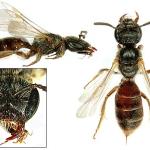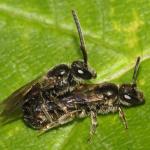Hylaeus parvulus Schenck, 1853, Halictus striatus Schenck, 1868, Halictus ferrugineipes Schenck, 1868
Although widespread, this is essentially a southern species, found from Cornwall to Kent and north to North Wales and Norfolk. There is also, however, an outlying locality in Cumberland, this being by far the most northerly occurrence. Absent from Ireland. It occurs on many of the Channel Islands.
Abroad, this is a western Palaearctic species, occurring to Iran in the east and north to southern Sweden and Lithuania.
This species is not regarded as being scarce or threatened.
Occurs in many open habitats, including, for example, open coppice, sandy heath and chalk grassland.
The female can be found flying from early March to October. The species is univoltine, however, the females overwintering as adults. The male is found on the wing from early July to early October.
A solitary mining bee. The nest is constructed in inclined or vertical faces, sometimes in the root bole earth of uprooted trees. After a short, nearly horizontal section, the burrow slopes down to several cells, each at the end of short, lateral burrows. The cells are ovoid, with the long axis nearly horizontal. The pollen mass is spheroid in form, its top slightly flattened.
The bee visits a wide variety of flowers, a few examples being: alexanders, blackthorn, lesser celandine, various crucifers, dandelion, firethorn, sallow, tormentil and wood spurge.
A putative host of several cleptoparasitic bees, including Sphecodes geoffrellus (Kirby), S. crassus Thomson, S. miniatus von Hagens, S. ephippius (Linnaeus) and Nomada sheppardana (Kirby). Specimens are occasionally collected carrying females of the stylops Halictoxenos.
2012



